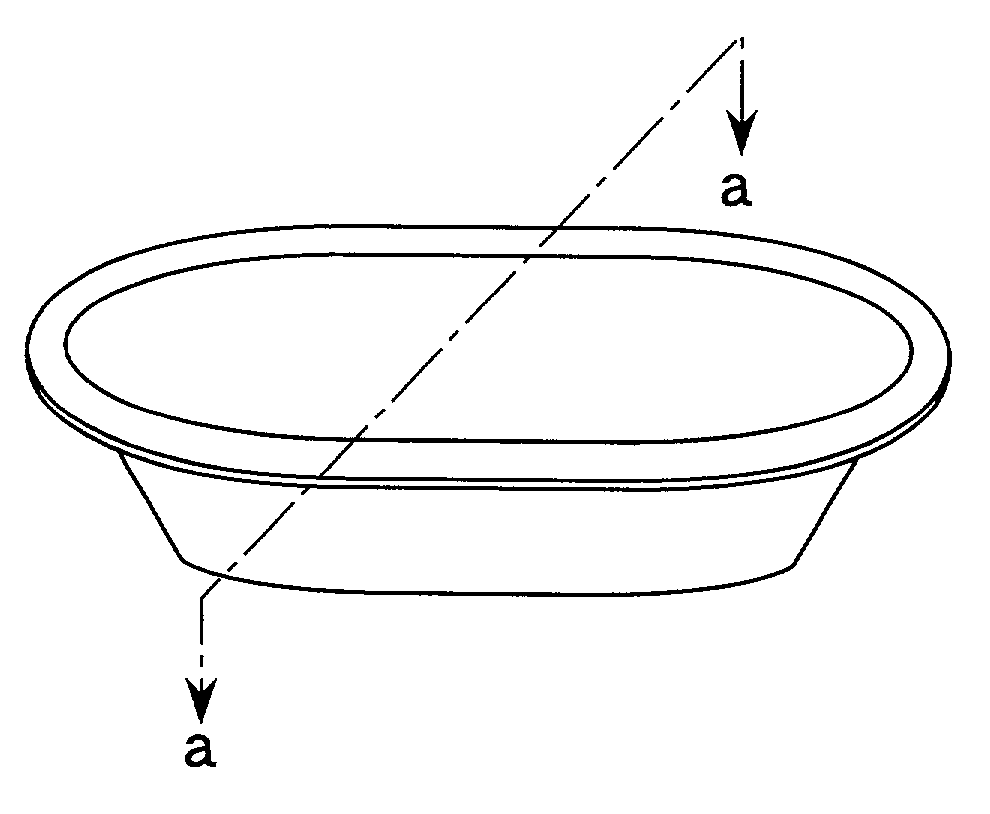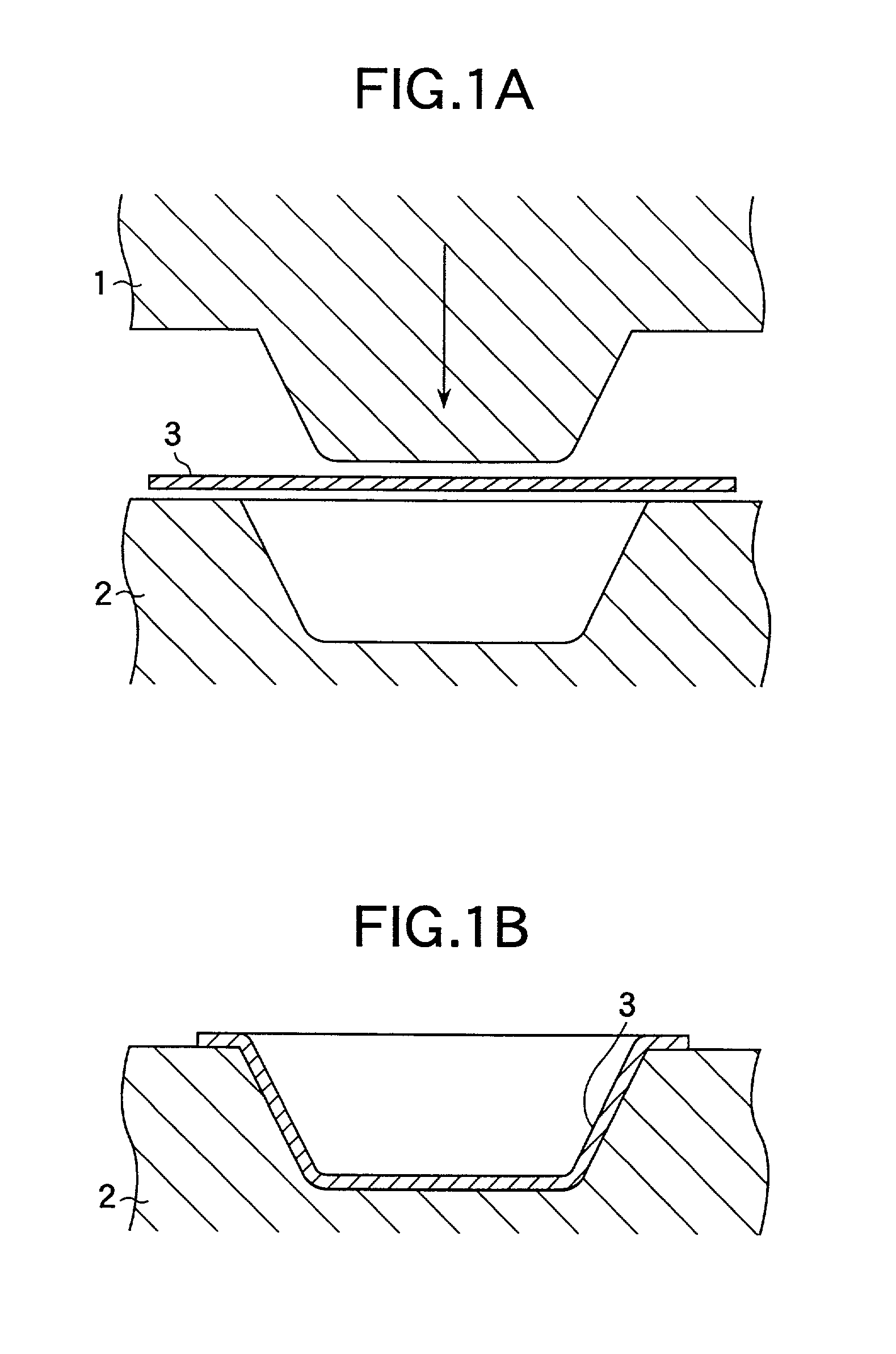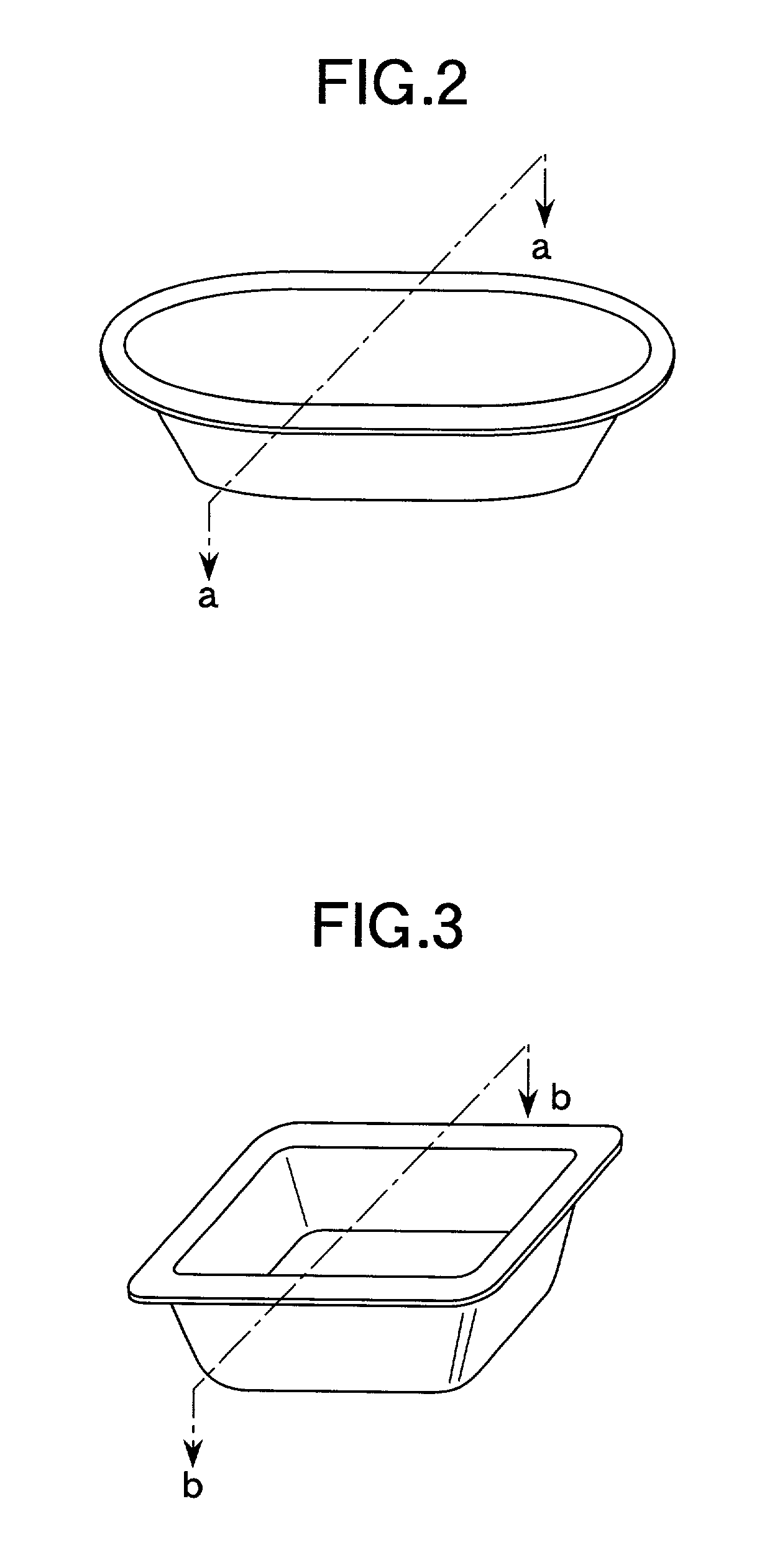However, these plastic vessels have a problem in that, when they are thrown away, the environment is burdened with a
heavy load.
However, the production of the pulp mold takes a time and it has a problem in the productivity.
Further, it is difficult to impart sufficient
water resistance and oil resistance, which are often demanded of tray vessels for foods, to the pulp molded vessels.
This technique increases the cost.
However, the base sheet mainly composed of paper pulp generally has poor drawing property,
extensibility and elasticity unlike resins and metals.
Therefore, when a deep press molding is conducted for the purpose of obtaining a tray having a certain deepness, such as 40 mm or deeper, the base sheet cannot bear the drawing and might be broken.
Thus, the shape of the obtained moldings was limited in the prior art.
In addition, even when the vessels were not broken, the folds at the
score lines become uneven and the vessel surface cannot be easily smoothened.
In case the
flange or rim of a tray, which extends horizontally and outwardly from the upper edge of the side wall of the tray, is uneven, a gap is formed due to the unevenness when the tray is covered with a lid or when it is sealed with a film or the like and accordingly the sealing is lowered.
Further, a
breaking point at the fold causes of lowering of the strength of the tray.
Thus, the corrugation step is necessitated before the pressing step and the corrugation still remains in the pressed vessel to impair the appearance of the vessel and also to make the strength of the vessel insufficient.
However, this method, wherein the corrugated sheet should be used as the base sheet, cannot be employed when an ordinary base material such as a
paperboard is used.
In addition, the creases caused by the pressing cannot be completely removed.
In addition, the use of the
thermoplastic resins in a large amount may result in a large problem in lowering recyclability and increasing the environmental load when it is thrown away.
The base sheets obtained by the above-described methods have the following defect: When a molding obtained by pressing them under pressure has a curved part of a serious
distortion, the unevenness of the creases is serious in the curved part and it cannot be removed by the pressing.
The moldability was thus not good.
Thus, the excellent moldability cannot be obtained in these cases.
When the basis weight is below 100 g / m.sup.2, the molded product obtained after the press molding cannot have a sufficient strength.
On the contrary, when the basis weight is above 500 g / m.sup.2, the moldability of the creased part is reduced unfavorably.
Therefore, the intermediate layer is desirably bulky.
On the contrary, when the density exceeds 0.9 g / cm.sup.3, the surface of the outer layer of the base paper becomes excessively tense.
Therefore, it is substantially difficult to obtain a layer having a higher density in the paper making step and, in addition, a suitable press moldability cannot be obtained.
When the basis weight is less than 15 g / m.sup.2, it may be difficult to obtain the layer having a high Young's modulus and also to make the paper itself.
This fact makes the production of a paper layer structure of a
low density difficult.
On the contrary, when the freeness is over 650 ml, the density of the sheet is excessively low and, therefore, the ply separation is caused in the pressing step in the paper making process to cause
balloon-like swelling.
In addition, when they are used, lowering in the density is only slight in the press-molding step.
When the basis weight of this
paper sheet is below 40 g / m.sup.2, the tensile strength of the sheet is insufficient and the sheet is easily broken in the molding step and, on the contrary, when it exceeds 300 g / m.sup.2, the density of the molding base paper obtained by the lamination with this
paper sheet as the crack preventing layer is increased to lower the moldability of the creased part of the molding unfavorably.
When the drawing is conducted by pressing under a very
high pressure, non-uniformity in color is caused along the
score line parts, in which the folding creases are formed, of the molding base paper which will be the surface of the vessel.
The color non-uniformity seriously damages the appearance of the product to reduce the commercial value thereof.
When it is below 30% by weight, a sufficient effect of concealing the color non-uniformity would not be obtained.
In particular, neck-in of the molten film occurs in T-die, and the
synthetic resin layer partially lacks because of insufficiency in
spreadability of the synthetic resin layer.
When the former is heavier than the latter, a bad influence would be exerted on the biodegradability of the tray or vessel itself.
When the
water content of the base paper is below 10%, the molding having a sufficient stiffness cannot be obtained.
On the other hand, when it exceeds 20%, the molding base paper is blistered and the
layers of the base paper are peeled off and, in addition, a long time is necessitated for
drying because the
water content is high and, as a result, the productivity is lowered unfavorably.
When the temperature of the heated molding base paper is below 100.degree. C., a long time is taken for the molding to lower the productivity and, on the contrary, when the temperature is higher than 150.degree. C., the base paper is easily blistered particularly when it has a
high water content.
When it is smaller than 10 kgf / cm.sup.2, the compression deformation in the scored part is insufficient and, on the contrary, when it exceeds 100 kgf / cm.sup.2, the paper layer is broken at the folding creased portions unfavorably.
When the
radius of curvature is small, the paper is easily broken at the corner, particularly at the four angular corners and, in addition, wrinkles at the corner between the side walls are easily increased.
When the
radius of curvature is large, a deep vessel cannot be obtained by the drawing and, the efficiency of the use of the material is low.
The obtained vessel is unsuitable for receiving materials having a
high water content or for liquids.
In addition, in such a case, the effect of the side wall for increasing the stiffness of the vessel is insufficient.
 Login to View More
Login to View More 


